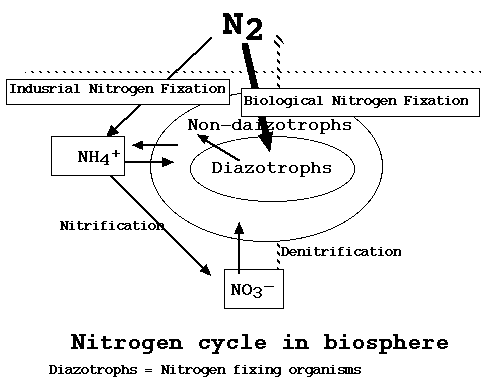Azotobacter
|
|
|
ClassificationHigher order taxa:
Species:Azotobacter chroococcum Description and Significance
Genome Structure
|
|
Azotobacters have generated a good deal of interest in the scientific community because of their unique mode of metabolism, by which they can fix nitrogen aerobically. The cells' uniquely high respiration rates allow the normally oxygen-sensitive nitrogenase to experience limited oxygen exposure. Azotobacter is also capable of producing a protein which protects the nitrogenase from sudden oxygen-provoked stress. Another individualistic trait of Azotobacter is their ability to synthesize not just one, but three nitrogenases. Specific genes are used to synthesize each nitrogenase. Azotobacter's cells are large rods, at least 2 microns in diameter. They can live singly, in chains, or in clumps, and may or may not be mobile by flagella. Their resting stage is spent as a thick-walled cyst, which protects the organism from harsh climates. |
Ecology
Diazotrophic organisms such as Azotobacter play a vital role in every ecosystem, working to make nitrogen available to all organisms. Azotobacters and similar bacteria turn nitrogen into ammonia through the process of nitrogen fixation, after which the ammonia is turned into proteins. Nitrogen fixation is used in agriculture in relation to crop rotation and fertilization; soil-dwelling diazotrophs such as Azotobacter are especially useful in gauging the health and virility of the ground. Azotobacters are found worldwide, in climates ranging from extremely northern Siberia to Egypt and India. {| width="100%"

Above are soil samples containing differing amounts of Azotobacter. The top left sample displays a healthy amount of Azotobacter, which decreases to moderate level in the top right and a poor level of Azotobacter in the bottom sample.
Image from N.A. Krasil'nikov.
References. Updated May 31, 2006
Azotobactercysts. The Microbe Zoo, Digital Learning Center for Microbial Ecology.
Azotobacter vinelandii.Molecular Microbiology Department, The John Innes Center.
Crum, Amy. Azotobacter: Soil Microbiology. Biology Department, Virginia Polytechnic Institute and State University.
Deacon, Jim. The Microbial World: The Nitrogen Cycle and Nitrogen Fixation. Institute of Cell and Molecular Biology, The University of Edinburgh.
JGI A. vinelandii Home. Eukaryotic Genomics, Doe Joint Genome Institute.
Krasil'nikov, N.A. Soil Microorganisms and Higher Plants. Academy of Sciences of the USSR Institute of Microbiology.
Watanabe, Iwao. Biological Nitrogen Fixation and its Use in Agriculture. Cantho University, Vietnam.


